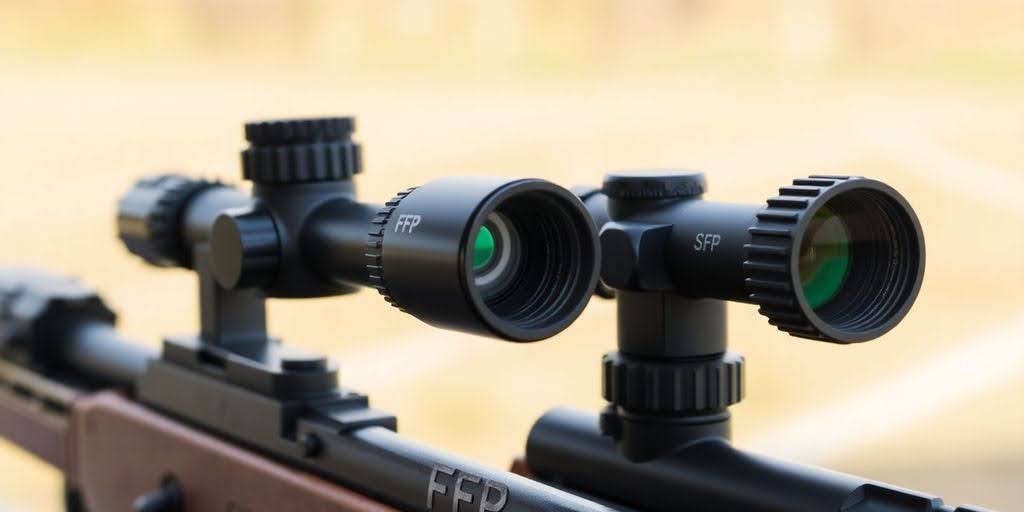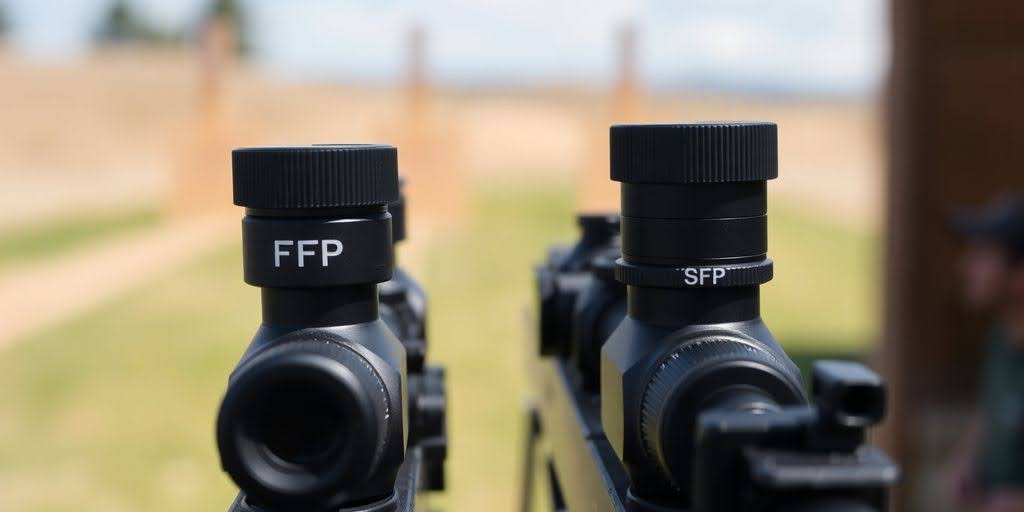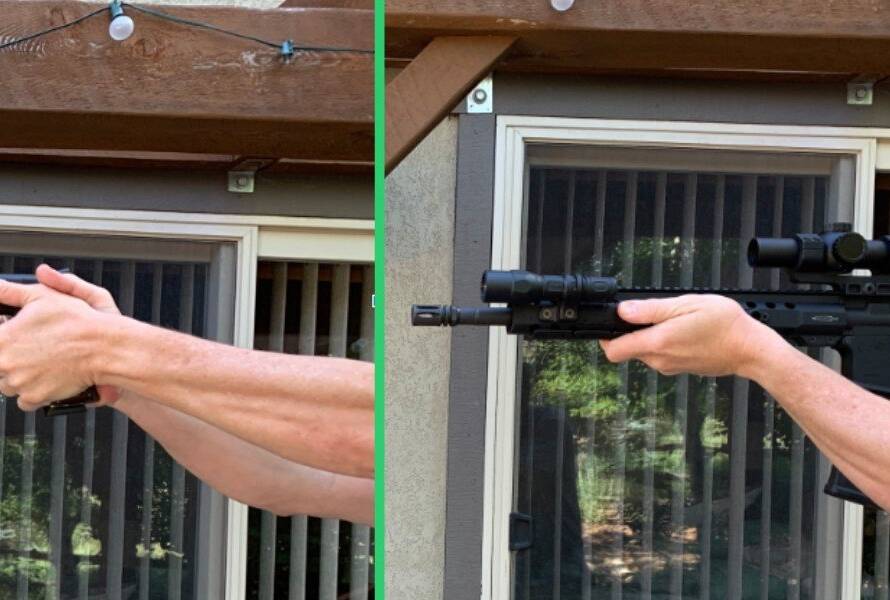When it comes to choosing the right scope for your shooting needs, understanding the differences between First Focal Plane (FFP) and Second Focal Plane (SFP) scopes is key. Each type has its own strengths and weaknesses, making them suitable for different shooting scenarios. This article will break down the basics of FFP vs SFP, helping you decide which scope fits your style and purpose best.
Key Differences Between FFP and SFP Scopes
Understanding Focal Planes
The primary difference between First Focal Plane (FFP) and Second Focal Plane (SFP) scopes lies in the placement of the reticle. In an FFP scope, the reticle is situated in front of the magnification lens, while in an SFP scope, it’s behind it. This seemingly small difference has significant implications for how the reticle appears and functions as the magnification is adjusted. Think of it like this: with FFP scopes, the reticle and the target image both get bigger or smaller together as you zoom. With SFP, only the target changes size.
How Reticle Size Changes
The most noticeable difference is how the reticle’s size changes with magnification. In an FFP scope, the reticle’s size increases or decreases proportionally with the magnification. This means that the reticle appears larger at higher magnifications and smaller at lower magnifications. Conversely, in an SFP scope, the reticle’s size remains constant regardless of the magnification setting. This can be beneficial in some situations, as the reticle doesn’t obscure the target at high magnifications.
Applications in Shooting
The different reticle behaviors make FFP and SFP scopes suitable for different shooting applications. FFP scopes are often favored for long-range shooting and tactical applications where accurate holdovers are crucial at varying distances. The reticle’s consistent subtensions allow shooters to quickly estimate range and make adjustments without having to recalculate for different magnification levels. SFP scopes, on the other hand, are often preferred for hunting and close-range shooting where a constant reticle size is desirable for quick target acquisition and a less cluttered sight picture.
Choosing between FFP and SFP scopes depends heavily on your shooting style and the types of scenarios you anticipate encountering. Understanding the core differences in reticle behavior is the first step in making an informed decision.
Advantages of FFP Scopes
Consistent Reticle Size
With a first focal plane (FFP) scope, the reticle’s size changes proportionally with the magnification. This means the reticle maintains its scale relative to the target image throughout the entire zoom range. This is super useful because the holdover points remain accurate, no matter the magnification. No need to recalculate!
Better for Long-Range Shooting
FFP scopes really shine when you’re reaching out to longer distances. Because the reticle’s measurements are consistent across all magnifications, making adjustments for bullet drop or wind drift becomes much simpler. This is especially helpful when you don’t have time to dial in your turrets. For example:
- Quick estimations of range.
- Fast compensation for bullet drop.
- Easy windage adjustments.
Using an FFP scope at long range can decrease the time it takes to make an accurate shot. With practice, it can extend your effective hunting range.
Quick Follow-Up Shots
In situations where you need to take a follow-up shot quickly, FFP scopes offer a distinct advantage. If your first shot misses, you can rapidly adjust your aim using the reticle’s holdover points without having to adjust the magnification or do any math. This is super useful in hunting or competitive shooting scenarios where every second counts. Military and police snipers also find FFP riflescopes useful when they need to make a rapid and precise follow-up shot.
Benefits of SFP Scopes
Stable Reticle Appearance
With a second focal plane (SFP) scope, the reticle’s size remains constant, regardless of the magnification. This is a big deal for many shooters because it provides a consistent sight picture. It means the reticle won’t appear to get thicker or thinner as you zoom in or out. This can be especially helpful in situations where a clear, unobstructed view of the target is paramount. The reticle maintains its visibility and doesn’t obscure smaller targets at higher magnifications.
Ideal for Close-Range Shooting
SFP scopes really shine in close-range scenarios. When you’re dealing with targets at shorter distances, the need for precise holdovers or range estimations is often less critical. The consistent reticle size in an SFP scope allows for quick target acquisition and intuitive aiming. This makes them a solid choice for hunting in dense environments or for tactical applications where speed and situational awareness are key.
Simplicity in Use
One of the biggest advantages of SFP scopes is their simplicity. There’s no need to worry about the reticle subtensions changing with magnification, which simplifies the process of aiming and making adjustments. This makes SFP scopes easier to learn and use, especially for newer shooters. It also means less mental calculation in the field, allowing you to focus on other important factors like windage and target movement.
SFP scopes offer a straightforward and reliable aiming solution, particularly for scenarios where rapid target acquisition and a clear sight picture are prioritized over long-range precision and complex calculations. This simplicity makes them a popular choice for many hunters and recreational shooters.
Here’s a quick comparison of SFP scope features:
- Consistent reticle size across all magnifications
- Simplified aiming process
- Ideal for close to medium range shooting
- Generally more affordable than FFP scopes
Choosing Between FFP and SFP

Okay, so you’re trying to figure out whether to go with an FFP or SFP scope. It can feel like a big decision, but let’s break it down into some manageable chunks. It really boils down to what kind of shooting you’re doing and what you value most in a scope. There’s no one-size-fits-all answer, so let’s get into the details.
Assessing Your Shooting Style
First off, think about how you actually shoot. Are you mostly at the range punching paper at known distances? Or are you out in the field, where distances are constantly changing and you need to make quick decisions? Your typical shooting environment will heavily influence whether FFP or SFP is a better fit. If you’re often adjusting magnification and need to use your reticle for ranging or holdovers, FFP might be the way to go. If you mostly shoot at a fixed magnification, or at closer ranges, SFP could be just fine. Consider these points:
- Do you frequently use holdovers?
- Are you often shooting at unknown distances?
- Do you adjust your magnification often in the field?
Considering Your Budget
Let’s be real, budget plays a big role. Generally, FFP scopes tend to be a bit pricier than SFP scopes. This is because the manufacturing process for FFP reticles, especially more complex ones, is more involved. That said, there are budget-friendly options in both categories. Don’t automatically assume you need to spend a fortune to get a good scope. Think about what features you really need and find the best scope within your price range. Sometimes, spending a bit more on quality glass is better than getting a cheaper scope with a bunch of features you won’t use. If you are looking for the best scope for your money, do your research.
Evaluating Intended Use
What are you actually going to be using the scope for? Is it for hunting, target shooting, or maybe even some tactical applications? Each of these has different requirements. For example, a hunter might prioritize a bright, clear image and a simple reticle, while a precision shooter might want a more complex reticle with precise measurements. Tactical applications might require a scope that can handle rapid adjustments and holdovers. Here’s a quick rundown:
- Hunting: Simplicity and brightness are key.
- Target Shooting: Precision and repeatability matter most.
- Tactical: Versatility and quick adjustments are important.
FFP vs SFP for Different Shooting Scenarios

Precision Rifle Competitions
In precision rifle competitions, where targets are often at varying distances, FFP scopes offer a significant advantage. The consistent reticle subtensions at all magnifications allow shooters to quickly and accurately estimate range and apply holdovers without needing to adjust calculations based on the magnification setting. This is crucial for speed and accuracy when every second counts.
Hunting Considerations
For hunting, the choice between FFP and SFP is more nuanced. SFP scopes are often preferred for close-range hunting where a clear, uncluttered reticle is beneficial. However, FFP scopes can be useful for longer-range hunting scenarios where holdovers are necessary. It really depends on the typical distances you expect to encounter. Many hunters find SFP scopes perfectly adequate for their needs, especially if they primarily hunt at shorter ranges.
Tactical Applications
In tactical situations, where speed and adaptability are paramount, FFP scopes are generally favored. The ability to quickly estimate range and apply holdovers, regardless of magnification, can be critical in dynamic environments. This is especially true for military and law enforcement snipers who may need to take rapid follow-up shots or work with a spotter calling corrections. The consistent reticle subtensions of FFP scopes allow for faster and more accurate adjustments in high-pressure situations.
Choosing between FFP and SFP for tactical applications often comes down to training and personal preference. Some operators prefer the simplicity of SFP scopes, while others value the versatility of FFP scopes. Ultimately, the best choice depends on the specific mission requirements and the individual’s skill set.
Here’s a quick comparison table:
| Feature | FFP | SFP |
| Reticle Size | Changes with magnification | Remains constant with magnification |
| Range Estimation | Consistent at all magnifications | Only accurate at specific magnification |
| Best Use | Long-range, tactical, competitions | Close-range hunting, general use |
| Learning Curve | Steeper | Easier |
Common Misconceptions About FFP and SFP
FFP is Always Better
It’s easy to fall into the trap of thinking that First Focal Plane (FFP) scopes are superior across the board, but that’s simply not true. While FFP scopes offer advantages in certain scenarios, they aren’t universally the best choice. The ideal scope depends heavily on the specific application and the shooter’s preferences. For example, a hunter primarily taking shots at close range might find an SFP scope more suitable.
SFP is Outdated
There’s a misconception that Second Focal Plane (SFP) scopes are old news, relics of a bygone era. This couldn’t be further from the truth. SFP scopes remain a popular and viable option for many shooters. Their stable reticle size and simpler design make them well-suited for various applications, particularly where ranging isn’t a primary concern. Plus, many experienced shooters simply prefer the familiar feel of an SFP scope.
Cost Implications
It’s often assumed that FFP scopes are always significantly more expensive than SFP scopes. While it’s true that high-end FFP scopes can command a premium price, there are also affordable FFP options available. Similarly, some high-quality SFP scopes can be quite costly. The price difference isn’t solely determined by the focal plane; other factors like glass quality, features, and brand reputation play a significant role.
Choosing between FFP and SFP isn’t about one being inherently superior. It’s about understanding the strengths and weaknesses of each type and selecting the scope that best aligns with your individual needs and shooting style. Consider what you value most in a scope and make an informed decision based on those priorities.
Real-World Examples of FFP and SFP Use
Military and Law Enforcement
In military and law enforcement scenarios, the choice between FFP and SFP scopes often depends on the specific mission requirements. FFP scopes are favored for their ability to provide accurate range estimations and holdovers at any magnification, which is critical in dynamic combat situations. Imagine a sniper needing to quickly adjust for bullet drop at varying distances; an FFP scope allows for faster calculations because the reticle’s measurements remain consistent regardless of the zoom level. SFP scopes, on the other hand, might be used in situations where target identification at lower magnifications is paramount, and quick adjustments aren’t as crucial. For example, police officers might prefer SFP scopes for close-quarters engagements where a clear, uncluttered sight picture is more important than long-range precision. The durability of the scope is also a key factor in these high-stress environments.
Competitive Shooting
Competitive shooting, especially in disciplines like Precision Rifle Series (PRS), sees a strong preference for FFP scopes. Here’s why:
- Consistent Holdovers: FFP scopes allow shooters to use their reticle for ranging and holdovers at any magnification, which is essential when engaging targets at unknown distances.
- Rapid Adjustments: Competitors often need to make quick adjustments based on wind and distance, and FFP scopes simplify this process.
- Complex Reticles: Many PRS shooters use scopes with sophisticated reticles designed for precise measurements, which are only effective if the reticle scales correctly with magnification.
SFP scopes can still be used in some competitions, particularly those with fixed distances or where the rules limit magnification adjustments. However, the flexibility and precision offered by FFP scopes generally make them the top choice for serious competitors. For example, a shooter using first focal plane scopes can quickly adapt to changing conditions without having to remember specific holdover values for different magnification settings.
Recreational Hunting
For recreational hunting, the choice between FFP and SFP scopes is more varied and often comes down to personal preference and the type of hunting being done. SFP scopes have traditionally been popular among hunters because of their simpler design and the fact that the reticle remains constant in size, making it easier to see in low-light conditions. This is especially useful when hunting in dense forests or during dawn and dusk. However, FFP scopes are gaining popularity, particularly among hunters who engage in long-range shooting or hunt in open terrain where precise holdovers are necessary.
A hunter might choose an SFP scope for deer hunting in wooded areas, where shots are typically taken at shorter distances and a clear, uncluttered view is more important than precise ranging. Conversely, a hunter pursuing elk in open country might opt for an FFP scope to accurately compensate for bullet drop at longer ranges.
Ultimately, the best choice depends on the individual’s hunting style, the typical distances involved, and their comfort level with the scope’s features.
Wrapping It Up
In the end, picking between FFP and SFP scopes really comes down to what you need. If you’re into long-range shooting or precision work, FFP might be the way to go. But if you’re mostly hunting at shorter distances, SFP could serve you just fine. Think about your shooting style, the distances at which you usually engage at, and what features matter most to you. Both types have their pros and cons, so weigh them carefully. No matter what you choose, getting familiar with your scope and practicing will make a big difference in your shooting experience.
Frequently Asked Questions
What’s the main difference between FFP and SFP scopes?
The key difference is how the reticle behaves with magnification. In FFP scopes, the reticle size changes with zoom, while in SFP scopes, the reticle size stays the same regardless of the zoom level.
Which type of scope is better for long-range shooting?
FFP scopes are usually better for long-range shooting since the reticle size adjusts with the magnification, making it easier to make accurate shots.
Are SFP scopes good for hunting?
Yes, SFP scopes are great for hunting, especially for shots at close to medium distances since the reticle size remains constant and is easier to see.
Can I use an FFP scope for close-range shooting?
While you can use an FFP scope for close-range shooting, the reticle may appear small at lower magnifications, which could make it harder to aim.
Do snipers prefer FFP or SFP scopes?
Most military and police snipers tend to favor FFP scopes because they allow for accurate adjustments at any magnification level.
Is it more expensive to buy an FFP scope than an SFP scope?
Generally, FFP scopes can be more expensive due to their complex design and features, but prices can vary based on brand and quality.




